Marine construction projects, which involve building structures in or near water bodies, present unique safety challenges. These projects require stringent safety standards to protect workers, the environment, and the integrity of the construction itself. Safety standards for marine construction services encompass regulatory compliance, risk management, training, equipment maintenance, and emergency preparedness. Understanding and implementing these standards is essential for minimizing accidents and ensuring successful project completion.
Navigating Safety: Essential Standards for Marine Construction Services
1. Regulatory Compliance
Marine construction services must comply with various international, national, and local regulations designed to ensure safety. Key regulatory bodies include:
- Occupational Safety and Health Administration (OSHA): OSHA sets forth guidelines to protect workers from hazards specific to marine construction. This includes regulations on fall protection, personal protective equipment (PPE), and safe operating procedures.
- International Maritime Organization (IMO): The IMO provides international regulations to ensure maritime safety and prevent marine pollution. Compliance with IMO standards is crucial for projects involving international waters.
- Environmental Protection Agency (EPA): The EPA sets regulations to protect the environment from construction-related activities, including water quality standards and pollution control measures.
Adhering to these regulations is fundamental to ensuring the safety and legality of marine construction operations.
2. Risk Management and Assessment
A thorough risk assessment is critical before commencing any marine construction project. This involves identifying potential hazards, evaluating the likelihood and impact of these hazards, and implementing measures to mitigate risks. Key aspects of risk management include:
- Site Surveys: Conducting detailed surveys to understand underwater and coastal conditions, including currents, tides, seabed composition, and weather patterns.
- Hazard Identification: Recognizing specific risks such as drowning, equipment failure, adverse weather, and environmental hazards.
- Risk Mitigation Plans: Developing strategies to address identified risks, including safety protocols, emergency response plans, and contingency measures.
Regular reviews and updates to risk assessments ensure that safety measures remain effective and relevant throughout the project.
3. Worker Training and Certification
Proper training and certification of personnel are vital for maintaining safety standards in marine construction. Key training requirements include:
- Marine Safety Training: Workers should be trained in marine-specific safety procedures, including the use of life-saving equipment, emergency drills, and man-overboard recovery techniques.
- Equipment Operation: Operators of cranes, barges, and other heavy machinery must be certified and proficient in using the equipment safely.
- First Aid and CPR: On-site workers should be trained in first aid and cardiopulmonary resuscitation (CPR) to provide immediate assistance in case of accidents.
- Hazardous Material Handling: Training on the safe handling and disposal of hazardous materials to prevent spills and contamination.
Continuous training and certification programs help keep workers updated on the latest safety practices and technologies.
4. Personal Protective Equipment (PPE)
The use of appropriate personal protective equipment (PPE) is essential to safeguard workers against various hazards. Standard PPE for marine construction includes:
- Life Jackets and Harnesses: To prevent drowning and provide buoyancy in case of falls into the water.
- Hard Hats and Safety Boots: To protect against head injuries and ensure footing on slippery surfaces.
- Gloves and Eye Protection: To safeguard against cuts, abrasions, and exposure to harmful substances.
- High-Visibility Clothing: To ensure workers are easily seen, especially in low-light conditions or near moving machinery.
Ensuring that PPE is regularly inspected, properly maintained, and correctly used is critical for worker safety.
5. Equipment Maintenance and Inspection
The maintenance and inspection of construction equipment are paramount to prevent accidents and equipment failure. Key practices include:
- Regular Inspections: Conducting routine checks on machinery, vessels, and safety gear to identify and address potential issues.
- Preventive Maintenance: Implementing a maintenance schedule to ensure that all equipment is in optimal working condition and compliant with safety standards.
- Certification and Documentation: Keeping accurate records of inspections, maintenance activities, and equipment certifications to ensure traceability and accountability.
By prioritizing equipment maintenance and inspection, marine construction projects can reduce the risk of mechanical failures and associated hazards.
6. Emergency Preparedness and Response
Effective emergency preparedness and response plans are crucial for managing accidents and unforeseen events. Key elements include:
- Emergency Action Plan (EAP): Developing a comprehensive EAP that outlines procedures for various emergency scenarios, including evacuation, medical emergencies, and environmental incidents.
- Communication Systems: Ensuring reliable communication channels for reporting emergencies and coordinating responses.
- Rescue and Recovery Operations: Equipping the site with necessary rescue equipment, such as lifeboats, first aid kits, and emergency response vessels.
- Regular Drills: Conducting regular emergency drills to familiarize workers with response procedures and improve readiness.
An effective emergency preparedness plan enhances the ability to respond swiftly and efficiently to incidents, minimizing potential harm.
7. Environmental Protection Measures
Protecting the marine environment is a key aspect of safety standards in marine construction. Key environmental protection measures include:
- Pollution Control: Implementing practices to prevent spills and contamination, such as using spill containment systems and following proper waste disposal protocols.
- Erosion Control: Employing techniques to minimize erosion and sediment runoff, such as silt curtains and erosion control blankets.
- Wildlife Protection: Taking steps to protect marine life, including timing construction activities to avoid disrupting breeding seasons and implementing noise reduction measures.
Integrating environmental protection into safety standards ensures the sustainability and ecological responsibility of marine construction projects.
Conclusion
Marine construction projects demand rigorous safety standards to protect workers, the environment, and project integrity. By adhering to regulatory requirements, conducting thorough risk assessments, ensuring proper training, maintaining equipment, and preparing for emergencies, marine construction services can minimize hazards and ensure successful project outcomes. Incorporating these safety standards not only complies with legal obligations but also promotes a culture of safety and sustainability in marine construction.








